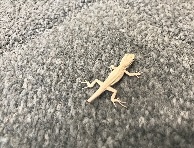Long-Tailed Brush Lizard (Urosaurus graciosus)
Description: U. graciosus is distinguishable from its close relative the tree lizard, Urosaurus ornatus, by the presence of a tail more than two times its snout-vent length and the absence of a series of smaller scales running down the middle of the band of enlarged dorsal scales. U. graciosus is distinguishable from the black-tailed brush lizard, Urosaurus nigricauda, by the presence of a tail more than two times its snout-vent length and relatively large dorsal scales transitioning abruptly into granular lateral scales (in U. nigricauda, the dorsal scales are only slightly enlarged and transition gradually into the granular lateral scales). It is distinguishable from all other brush lizards (Urosaurus) by geography.
Habitat: This is a desert species that frequents areas of loose sand and scattered bushes and trees such as creosote bush, burrowbush, catclaw, mesquite, ironwood, paloverde, or saltbush; it also occurs in olive trees and Washington palms near houses in some desert towns, and in association with low-growing halophytic vegetation along beaches in Baja California; usually it is found on the branches of trees and shrubs in flat, open sandy areas or in wide canyon bottoms; it may dig into sand or use burrows at night
Range: U. graciosus occurs in the Mojave Desert and the northwestern Sonoran Desert in the U.S. states of California, Arizona and Nevada, and in the Mexican states of Baja California and Sonora.
Found in these States:
AZ |
CA |
NV
Diet: Insects (beetles, ants, bees, hemipterans, etc.), spiders, and some plant material.
Reproduction: U. graciosus is oviparous. Mates during the spring. Lays 1 (perhaps 2) clutches of 2-10 eggs May-August .
Status: Listed as Least Concern in view of its wide distribution, presumed large population, and because it is unlikely to be declining fast enough to qualify for listing in a more threatened category.
Subspecies:Two subspecies are recognized as being valid, including the nominotypical subspecies.
Western Brush Lizard - (Urosaurus graciosus graciosus)
Arizona Long-tailed Brush Lizard - (Urosaurus graciosus shannoni) - No Data available for this subspecies found in AZ
»» Kingdom: Animalia - Animals
»» Phylum: Chordata - Chordates
»» Subphylum: Vertebrata - Vertebrates
»» Class: Reptilia - Reptiles
»» Order: Squamata - Lizards
»» Family: Phrynosomatidae - North American Spiny Lizards
»» Genus: Urosaurus
»» Species: Urosaurus graciosus - Long-Tailed Brush Lizard
»» Subspecies: Two
»»
Urosaurus graciosus graciosus - Western Brush Lizard
»»
Urosaurus graciosus shannoni - Arizona Long-tailed Brush Lizard
This article uses material from the Wikipedia article "Urosaurus graciosus", which is released under the Creative Commons Attribution-Share-Alike License 3.0. Content may have been omitted from the original, but no content has been changed or extended.
|








